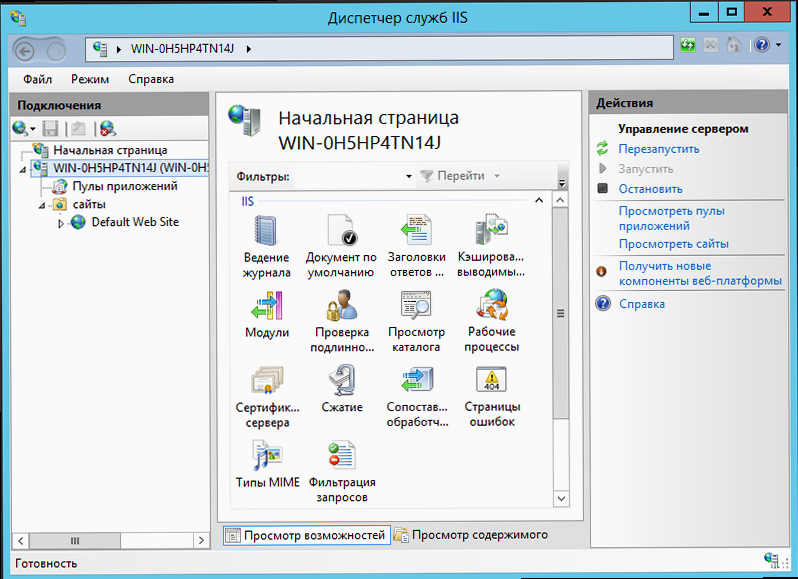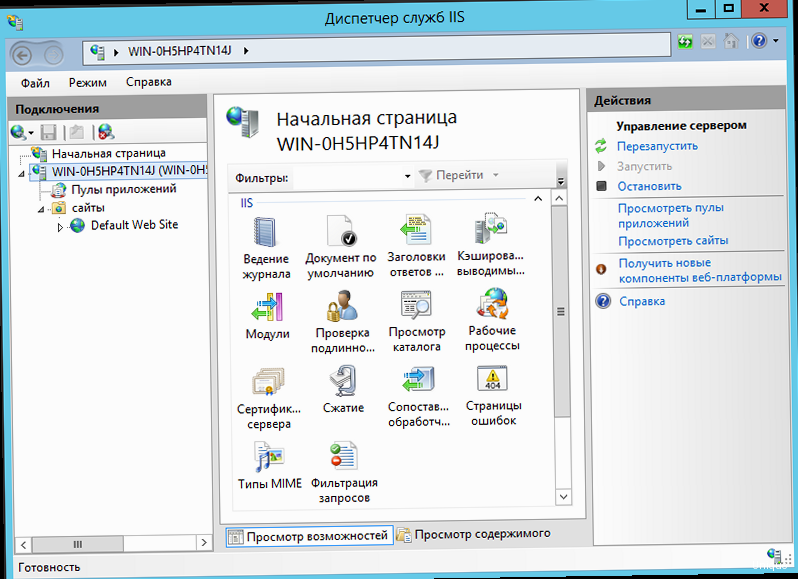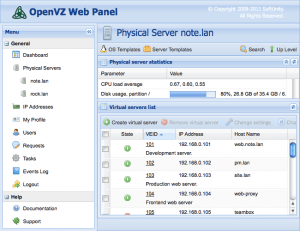How to Install and Configure a Web Server on Windows VPS?
In this comprehensive guide, we’ll walk through the step-by-step process of installing and configuring a web server on a Windows-based Virtual Private Server (VPS). We will cover how to install and configure IIS (Internet Information Services), Microsoft’s web server, and provide alternative options and optimization tips to improve the performance and security of your website or application. Whether you are a novice web developer or an experienced system administrator, this guide will provide you with all the information you need to successfully launch your web server.
Table of Contents
- Installing IIS on Windows VPS
- Basic IIS Configuration
- Configuring the Firewall for the Web Server
- Installing PHP and MySQL
- Deploying a Website
- Security and Optimization
Installing IIS on Windows VPS
 Install Windows Server 2022 on a VPS: A Step-by-Step Guide" class="internal-post-link">Windows Server Manager highlighting IIS." title="Illustration for Screenshot of the 'Add Roles and Features Wizard' in Windows Server Manager highlighting IIS." width="512" height="512" / class="wp-image-5107 wp-image-12400">
Install Windows Server 2022 on a VPS: A Step-by-Step Guide" class="internal-post-link">Windows Server Manager highlighting IIS." title="Illustration for Screenshot of the 'Add Roles and Features Wizard' in Windows Server Manager highlighting IIS." width="512" height="512" / class="wp-image-5107 wp-image-12400">IIS (Internet Information Services) is a powerful and flexible web server developed by Microsoft that integrates with the Windows operating system. To begin installing IIS on your Windows VPS, you must follow these steps. First, connect to your server via Remote Desktop Connection (RDP). Then open Server Manager. In Server Manager, select «Add roles and features».
On the first screen of the wizard, click «Next». On the next screen, select «Role-based or feature-based installation» and click «Next». Select your server from the list of servers and click «Next». On the «Select server roles» screen, select «Web Server (IIS)». A window will appear asking you to install additional components. Click «Add Features» and then «Next». On the «Select features» screen, leave the default settings and click «Next».
On the «Web Server Role (IIS)» screen, review the information and click «Next». On the «Select role services» screen, select the necessary components. It is recommended to select the following components: «Static Content», «Default Document», «Directory Browsing», «HTTP Errors», «HTTP Logging», «Request Filtering», «Static Content Compression», «Health and Diagnostics». If you plan to use ASP.NET, select the corresponding ASP.NET components (for example, ASP.NET 4.8). After selecting the components, click «Next».
On the installation confirmation screen, make sure that all selected components are listed correctly, and click «Install». The installation process may take some time. After the installation is complete, restart the server. After the server restarts, IIS will be installed and running. To verify, open a browser and go to http://localhost or http://<your_ip_address>. If IIS is installed correctly, you will see the IIS welcome page.
# Check the status of the IIS service
Get-Service W3SVC
# Restart the IIS service
Restart-Service W3SVC
# Get a list of installed IIS components
Get-WindowsFeature -Name Web-ServerIf you encounter problems during installation, check the Windows event log for errors. Also, make sure that your Windows VPS has Internet access to download the necessary components. Here is an example PowerShell command to check the status of the IIS service:
Get-Service W3SVC | Format-ListThis will show you more detailed information about the service, including its status, name, and description. If the service is not running, try starting it manually using the command:
Start-Service W3SVCIf this does not help, check for port conflicts. IIS by default uses ports 80 (HTTP) and 443 (HTTPS). Make sure that no other application is using these ports. You can check the occupied ports using the command:
netstat -ano | findstr :80
netstat -ano | findstr :443If any process is using these ports, you will need to either stop that process or change the ports used by IIS. Optimizing IIS performance includes configuring application pool settings, enabling static and dynamic content compression, and using caching. Regularly updating IIS and the Windows operating system is also an important aspect of maintaining the security and performance of your web server.
“Securing a web server is a continuous process that requires constant monitoring and updating.”John Doe, Cybersecurity Expert
Basic IIS Configuration

After successfully installing IIS, it is necessary to perform the basic configuration of the web server so that it can correctly serve your website or application. Basic configuration includes setting up sites, application pools, and virtual directories. Open IIS Manager by selecting «Internet Information Services (IIS) Manager» from the «Tools» menu in Server Manager or simply finding it via Windows search.
In IIS Manager, expand your server name in the left panel. Then expand the «Sites» node. By default, there will only be «Default Web Site». To create a new website, right-click on the «Sites» node and select «Add Web Site…». In the window that appears, specify the site name (for example, «MyWebsite»), the physical path to the folder where your site files will be stored (for example, «C:\inetpub\wwwroot\MyWebsite»), and the IP address and port on which the site will operate. If you want the site to be accessible by a domain name, specify it in the «Host name» field.
For example, if you want your site to be accessible at www.example.com, specify this in the «Host name» field. After entering all the necessary data, click «OK». IIS will create a new website. Then you need to create or configure an application pool. Application pools isolate web applications from each other, which increases the security and stability of the web server. To create a new application pool, right-click on the «Application Pools» node in IIS Manager and select «Add Application Pool…».
Specify the application pool name (for example, «MyWebsitePool»), select the .NET Framework version (for example, «.NET CLR v4.0») and the pipeline mode (Integrated or Classic). Integrated mode provides better performance and integration with ASP.NET. After entering all the necessary data, click «OK». Now you need to associate your website with the created application pool. Right-click on your website in IIS Manager and select «Manage Web Site» -> «Advanced Settings…». In the window that appears, find the «Application Pool» setting and select the application pool you created from the drop-down list. Click «OK».
Virtual directories allow you to map physical folders on your server as logical directories in the structure of your website. To create a virtual directory, right-click on your website in IIS Manager and select «Add Virtual Directory…». Specify the name of the virtual directory (for example, «images»), the physical path to the folder you want to display (for example, «C:\images»), and click «OK». Now you can access the files in the «C:\images» folder via the URL http://www.example.com/images/.
# Check the website configuration
Get-Website -Name "MyWebsite" | Format-List
# Change the website port
Set-Website -Name "MyWebsite" -Port 8080
# Get a list of application pools
Get-WebAppPoolStateConfiguring authentication and authorization. IIS supports various authentication methods, including anonymous authentication, basic authentication, Windows authentication, and ASP.NET authentication. You can configure authentication for your website or individual virtual directories. In IIS Manager, select your website or virtual directory and click the «Authentication» icon. Select the authentication method you want to use and configure its settings. Configuring logging. IIS keeps access logs for your website, which can be useful for debugging and traffic analysis. You can configure logging settings, such as the log format, log location, and log rotation frequency.
In IIS Manager, select your website and click the «Logging» icon. Select the log format, specify the log location, and configure other settings. Here is an example PowerShell command to get information about a specific site:
Get-Website -Name "MyWebsite" | Get-WebBindingThis command will show you all bindings for the «MyWebsite» site, including the IP address, port, and host name. It is also helpful to configure limits for the application pool to avoid server overload. For example, you can set a limit on memory usage or the number of worker processes. This can be done in the application pool settings in IIS Manager. Regularly check the IIS logs for errors and problems. This will help you identify and fix problems in time before they affect your website users.
“Optimizing IIS settings is the key to high performance and stability of your web server.”Maria Ivanova, Microsoft Certified Specialist
Configuring the Firewall for the Web Server
Correctly configuring Windows Firewall is a critical step in ensuring the security of your web server. The firewall controls incoming and outgoing network traffic, blocking unauthorized access to your server and protecting it from malicious attacks. By default, Windows Firewall will block all incoming traffic except traffic allowed by explicitly created rules. Therefore, you need to create rules allowing incoming traffic on the ports used by your web server (usually ports 80 and 443).
To configure the firewall, open «Windows Defender Firewall with Advanced Security». You can find it via Windows search or in Server Manager -> Tools. In the left panel, select «Inbound Rules». In the right panel, click «New Rule…». In the rule creation wizard, select «Port» and click «Next». Select «TCP» and specify ports 80 and 443 in the «Specific local ports» field. Separate the ports with a comma if there are several (for example, «80,443»). Click «Next».
Select «Allow the connection» and click «Next». Select the network profiles to which the rule will apply (Domain, Private, Public). Usually it is enough to select Domain and Private. Click «Next». Specify the name of the rule (for example, «Allow HTTP/HTTPS») and a description. Click «Finish». Now you have created a rule allowing incoming traffic on ports 80 and 443. Repeat these steps to create a rule allowing incoming traffic on other ports that may be used by your web server (for example, port 21 for FTP, if you are using FTP).
To improve security, it is recommended to restrict access to your web server only from certain IP addresses or IP address ranges. You can do this by adding a condition to the firewall rule. Right-click on the created rule and select «Properties». Go to the «Scope» tab. In the «Remote IP addresses» section, select «These IP addresses» and click «Add…». Specify the IP address or range of IP addresses from which you want to allow access to your web server. Click «OK».
Windows Defender Firewall also allows you to keep logs of firewall events, which can be useful for debugging and analyzing problems with network traffic. To enable logging, right-click on «Windows Defender Firewall with Advanced Security» in the left panel and select «Properties». Go to the «Logging» tab. Specify the path to the log file, the maximum size of the log file, and other parameters. Click «OK».
# Check firewall rules
Get-NetFirewallRule -Name "Allow HTTP/HTTPS" | Format-List
# Enable firewall rule
Enable-NetFirewallRule -Name "Allow HTTP/HTTPS"
# Disable firewall rule
Disable-NetFirewallRule -Name "Allow HTTP/HTTPS"Here is an example PowerShell command to add a firewall rule allowing incoming traffic on port 80:
New-NetFirewallRule -DisplayName "Allow HTTP" -Direction Inbound -Action Allow -Protocol TCP -LocalPort 80And here is an example command to add a rule allowing incoming traffic on port 443:
New-NetFirewallRule -DisplayName "Allow HTTPS" -Direction Inbound -Action Allow -Protocol TCP -LocalPort 443Regularly check the firewall logs for suspicious activity. This will help you identify and prevent attacks on your web server in time. It is also important to monitor firewall updates and install them in a timely manner. Updates often contain bug fixes and vulnerabilities that can be exploited by attackers. Do not disable the firewall unless absolutely necessary. The firewall is an important component of the security system of your web server. Disabling the firewall significantly increases the risk of attacks on your server. Instead of disabling the firewall, it is better to configure it correctly so that it only allows the necessary traffic.
| Function | Recommended Setting | Alternative Setting |
|---|---|---|
| Inbound Rules | Allow HTTP/HTTPS | Restrict by IP |
| Outbound Rules | Allow all outbound | Restrict as needed |
| Logging | Enabled with reasonable file size | Disabled (not recommended) |
Installing PHP and MySQL
To run many modern websites and applications, such as WordPress, Joomla, and Drupal, you need to install PHP and MySQL on your Windows VPS. PHP is a popular programming language used to create dynamic web pages, and MySQL is a widely used database management system. Installing PHP on Windows VPS is slightly different from installing on Linux VPS. You will need to download the PHP binaries from the official PHP website (https://www.php.net/downloads.php) and configure IIS to use them.
Download the latest version of PHP (in Zip format) for Windows from php.net. Choose the «VC15 x64 Non Thread Safe» or «VC16 x64 Non Thread Safe» version, depending on your version of Visual C++ Redistributable. Unzip the downloaded archive into a folder on your server (for example, «C:\php»). Rename the file «php.ini-development» to «php.ini». Open the «php.ini» file in a text editor and make the necessary changes. Uncomment the line ;extension_dir = "ext" by removing the «;» character. Set the path to the folder with PHP extensions: extension_dir = "C:\php\ext". Uncomment the necessary PHP extensions by removing the «;» character before them. For example, to work with MySQL you will need to uncomment the extension=mysqli extension.
Now you need to configure IIS to use PHP. The easiest way is to use PHP Manager for IIS. Download and install PHP Manager for IIS from iis.net. After installing PHP Manager, open IIS Manager. Select your server in the left panel. Double-click the «PHP Manager» icon. If PHP Manager is not installed, this icon will be missing. In PHP Manager, click «Register new PHP version». Specify the path to the «php-cgi.exe» file in the PHP folder (for example, «C:\php\php-cgi.exe»). PHP Manager will automatically configure IIS to use the selected version of PHP.
To install MySQL, download and install MySQL Installer for Windows from mysql.com. Select the «MySQL Installer MSI» version. Run MySQL Installer and select the «Server Only» installation type. Follow the instructions in the installation wizard. During installation, you will be prompted to select a configuration type. Select «Development Machine» for small websites or «Server Machine» for larger websites. Specify a password for the root user. Select «Standard System Account» to run the MySQL service. Click «Execute» to apply all settings.
After installing PHP and MySQL, you need to check that they are working correctly. Create a file «phpinfo.php» in the root folder of your website (for example, «C:\inetpub\wwwroot\phpinfo.php») with the following content:
<?php
phpinfo();
?>Open a browser and go to http://www.example.com/phpinfo.php. If PHP is installed correctly, you will see a page with information about the PHP configuration. To check the MySQL installation, create a PHP script that connects to the MySQL database and executes a query. For example:
<?php
$servername = "localhost";
$username = "root";
$password = "your_password";
$dbname = "your_database";
// Create connection
$conn = new mysqli($servername, $username, $password, $dbname);
// Check connection
if ($conn->connect_error) {
die("Connection failed: " . $conn->connect_error);
}
echo "Connected successfully";
$conn->close();
?># Check PHP version
php -v
# Restart the MySQL service
Restart-Service MySQL80
# Install PHP extension
Install-Module -Name PHP -Version 8.1Make sure that the MySQLi extension is enabled in the php.ini file, as described above. Replace «your_password» with the MySQL root user password and «your_database» with the name of an existing MySQL database. Save the script to a file and run it through a browser. If MySQL is installed correctly, you will see the message «Connected successfully». Here is an example command to view installed PHP extensions:
php -mThis will show a list of all loaded PHP extensions. If you are using WordPress, after installing PHP and MySQL you will need to create a database for WordPress in MySQL and configure the wp-config.php file with the database connection parameters. Instructions for installing WordPress can be found on the official WordPress website (https://wordpress.org/). Regularly update PHP and MySQL to the latest versions to ensure security and bug fixes. Use strong passwords for MySQL accounts to prevent unauthorized access to your databases.
| Component | Recommended Version | Settings |
|---|---|---|
| PHP | 8.1 or higher | Enable necessary extensions |
| MySQL | 8.0 or higher | Set a strong password for root |
Deploying a Website
«`After installing and configuring the web server, PHP, and MySQL, you need to place your website files on the server to make it accessible on the Internet. Hosting a website involves uploading the website files to the server, configuring DNS for the domain name, and testing the website’s functionality. There are several ways to upload website files to the server: FTP, SFTP, Web Deploy, and a file manager. FTP (File Transfer Protocol) is a standard protocol for transferring files between a computer and a server. SFTP (Secure File Transfer Protocol) is a more secure version of FTP that uses encryption.
To use FTP or SFTP, you will need an FTP client, such as FileZilla, WinSCP, or Cyberduck. Enter the server address (IP address or domain name), username, and password to connect to the server. Navigate to the root folder of your website (e.g., «C:\inetpub\wwwroot» or «C:\inetpub\wwwroot\MyWebsite»). Upload the website files from the local folder on your computer to the root folder on the server. Web Deploy is a tool from Microsoft for deploying web applications. It provides a more efficient and reliable way to deploy than FTP. To use Web Deploy, you need to install Web Deploy on your server and configure website publishing in Visual Studio or another development tool.
Some hosting providers offer a file manager through a web interface, which allows you to upload and manage website files directly through a browser. This is the easiest way to upload files, but it can be slow and inconvenient for large websites. After uploading the website files, you need to configure DNS for your domain name so that it points to the IP address of your server. DNS (Domain Name System) is a system that translates domain names into IP addresses. To configure DNS, you need to log in to the control panel of your domain name at your domain registrar.
Create an A (Address Record) record for your domain name, pointing to the IP address of your server. You can also create a CNAME (Canonical Name Record) record for the «www» subdomain, pointing to your domain name. For example, if your domain name is «example.com», create an A record for «example.com» pointing to the IP address of your server, and a CNAME record for «www.example.com» pointing to «example.com». After configuring DNS, it may take some time (up to 48 hours) for the changes to take effect and your website to become available on the Internet. After configuring DNS, you need to check that your website is working correctly. Open a browser and go to your domain name (e.g., http://www.example.com).
Make sure the website is displayed correctly and all functions work as expected. Check all links, images, and forms on your website. Check the operation of your website in different browsers and on different devices. If you are using WordPress, make sure you have correctly configured the wp-config.php file with the database connection parameters. If you are using other CMS or frameworks, make sure you have correctly configured the database connection parameters in the corresponding configuration files. If you encounter problems when hosting your website, check the web server logs for errors. The web server logs contain information about all requests to your website and can help you identify and resolve problems.
# Check DNS record
nslookup example.com
# Check port 80 availability
Test-NetConnection -ComputerName example.com -Port 80
# Get server IP address
Resolve-DnsName example.comHere is an example command to check the DNS record of a domain:
nslookup example.comThis command will show the IP address that the domain name points to. Make sure this IP address matches the IP address of your server. After uploading the site files to the server and configuring DNS, it may take some time for the DNS records to propagate (DNS propagation). During this time, your site may be unavailable or available from different IP addresses in different parts of the world. You can check the status of DNS record propagation using online tools, such as DNS Checker ( https://dnschecker.org/ ). Regularly back up your website and database so that you can quickly restore your website in the event of a failure. Automate the backup process using scripts or backup tools. Store backups in a safe place, such as cloud storage.
Security and optimization
Ensuring the security and optimizing the performance of your web server are important aspects of maintaining the stable and secure operation of your website or application. Security involves protecting your server from attacks, malware, and unauthorized access. Performance optimization involves configuring the server to load web pages quickly and use resources efficiently. Installing an SSL certificate is an important step in ensuring the security of your website. SSL (Secure Sockets Layer) is a protocol that encrypts data transmitted between the browser and the server, protecting it from interception and theft.
Get an SSL certificate from a trusted SSL certificate provider, such as Let’s Encrypt, Comodo, or DigiCert. Install the SSL certificate on your web server. In IIS Manager, select your website and click on the «Bindings» icon. Click «Add…». Select «https» in the «Type» field. Select your SSL certificate in the «SSL certificate» field. Click «OK». After installing the SSL certificate, make sure your website is accessible over HTTPS. Open a browser and go to https://www.example.com. Make sure that a lock icon is displayed in the browser’s address bar, indicating that the connection is secure.
Regularly update the Windows operating system and all installed software, including IIS, PHP, and MySQL. Updates often contain bug fixes and vulnerabilities that can be exploited by attackers. Use strong passwords for all accounts on your server, including administrator accounts, FTP users, and MySQL users. Enable the Windows Firewall and configure it correctly so that it only allows the necessary traffic. Use an intrusion detection system (IDS) or intrusion prevention system (IPS) to detect and block suspicious activity on your server. Regularly check web server and firewall logs for suspicious activity.
Enable Gzip compression to reduce the size of transmitted files and speed up the loading of web pages. In IIS Manager, select your server and click on the «Compression» icon. Enable compression for static and dynamic content. Use caching to store frequently used data in memory to reduce the load on the server and speed up the loading of web pages. Configure caching in IIS Manager





